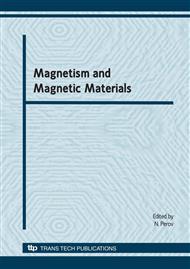p.198
p.205
p.209
p.213
p.217
p.221
p.225
p.229
p.233
SQUID-Based Relaxometric Diagnostics of Magnetic Nanoparticles
Abstract:
The method of SQUID-based relaxometric diagnostics has been applied to the ensembles of non-interacting near-spherical Fe3O4 and Co nanoparticles in order to reveal the behavior of the anisotropy constant upon varying the molecular surrounding of nanoparticles by using different polymer matrices. The transmission electron microscopy (TEM) and X-ray diffraction techniques have been employed to obtain the structural information about objects of study. The relaxation curves measured with the SQUID-relaxometer in the time range from about 50 s to several tens of seconds after application of a pulse of low dc magnetizing field have been approximated by theoretical dependences calculated within the framework of activation Néel–Arrhenius law with account for the size distribution functions retrieved from TEM data. From results of approximations, the values of anisotropy constant have been determined.
Info:
Periodical:
Pages:
217-220
Citation:
Online since:
April 2009
Price:
Сopyright:
© 2009 Trans Tech Publications Ltd. All Rights Reserved
Share:
Citation:


